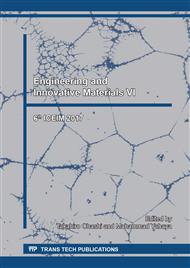p.332
p.337
p.342
p.347
p.352
p.359
p.364
p.369
p.374
A Varied Alkyl Chains of Ruthenium(II) Complexes for Dye Sensitized Solar Cells (DSSCs)
Abstract:
Ruthenium(II) complexes were synthesized and characterized for dye-sensitized solar cells (DSSCs) with varied alkyl chains specifically methyl (PC01), hexyl (PC02) and octyl (PC03). The photophysical property was studied by UV-Visible absorption. The results showed that the main absorption peaks were asigned to the metal to ligand charge transfer (MLCT) transition (350-600 nm). The incident photon to current conversion efficiency (IPCE) covered the entire visible spectrum reaching to 18-20% at 520 nm. The DSSC performances were investigated with liquid iodide/tri-iodide electrolyte under standard AM 1.5. PC01-PC03 showed that the power conversion efficiency (h) were obtained at 3.08%, 3.18% and 3.14%, respectively, compared with N719 (7.80%). Interestingly, PC02 and PC03 showed the long term stability with %hloss better than the standard up to 1000 h.
Info:
Periodical:
Pages:
359-363
Citation:
Online since:
January 2018
Authors:
Price:
Сopyright:
© 2018 Trans Tech Publications Ltd. All Rights Reserved
Share:
Citation:


